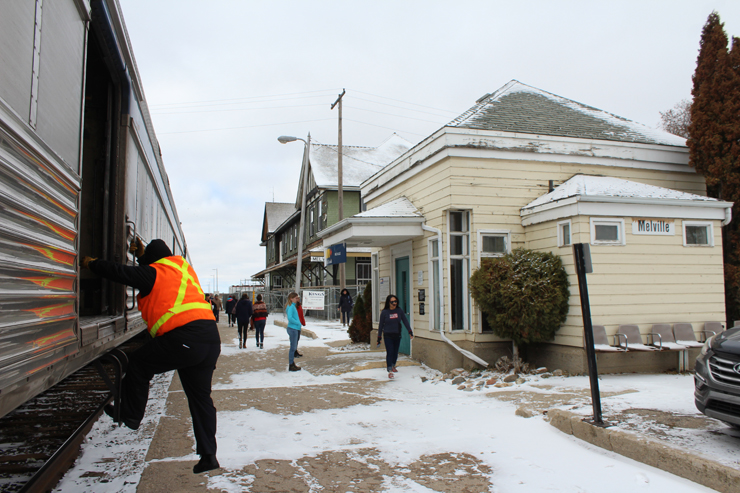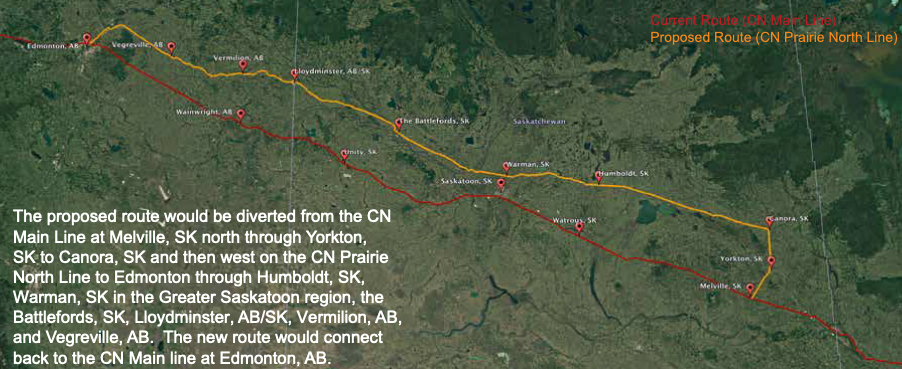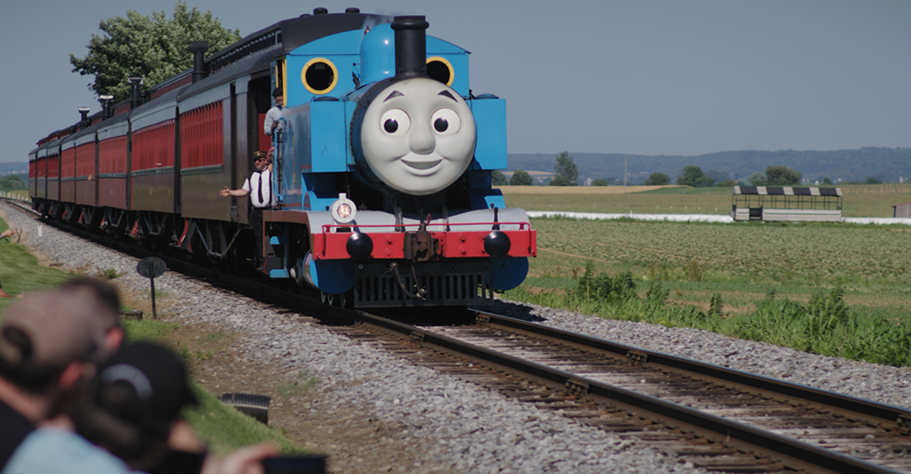
SASKATOON, Saskatchewan — A group of mayors in Saskatchewan are proposing to shift the route of VIA Rail Canada’s Canadian northward from its current route to Canadian National’s Prairie North Line, saying the shift would offer a number of benefits for the passenger train.
The mayors of Lloydminster, North Battleford, Warman, and Yorkton, Sask., presented the proposal at a meeting in Saskatoon, Sask., on Tuesday, Dec. 12. They say it would increase the population served by the train in communities along the route, improve timekeeping by moving the Canadian away from heavier freight traffic, offer a more scenic route, bring the train closer to a number of National Parks and National Historic Sites, and connect more Indigenous and rural communities.
A table in the presentation accompanying their proposal says the population of communities along the Prairie North Line is more than 128,000, compared to about 22,600 on the current route. (This excludes the populations of the Edmonton and Saskatoon areas, which would be served by either route, although service for Saskatoon from the Prairie North Line would be in the form of a stop at Warman, some 20 miles to the north.) The Prairie North Line would add about 60 miles to the length of the trip.
“The opportunity to help grow Indigenous and non-Indigenous tourism businesses is key to helping grow our economy for the prairies, and having VIA Rail travel with foreign tourists to the areas rich in Indigenous history and culture is the first step,” Lloydminster Mayor Gerald Aalbers said in a press release.
CTV News reports Aalbers said the proposal is still in its “infancy” during Tuesday’s meeting, which was to seek Saskatoon’s support for the proposal with VIA Rail Canada and the federal government. Saskatoon’s support, Aalbers said, could help the concept “actually garner the attention that it needs and make it an issue that Western Canada would like to see addressed.”

— Updated at 7:55 p.m. CDT to clarify that service for Saskatoon from the rerouted Canadian would involve a stop at Warman, Sask.














Mayor need to deal with municipal matters. Lines on a map and what is on the ground are often different. Plus I don’t believe the Mayors are aware of bolted rail, hand thrown switches, CTC…. It looks good on paper but.
My comments in the “SASKTODAY” Facebook page about this article:
https://www.sasktoday.ca/central/local-news/yorkton-mayor-part-of-effort-to-switch-via-rail-service-route-7958083?utm_source=dlvr.it&utm_medium=facebook
All the things the “Prairie North” report got wrong or is misleading:
“The Super Continental route also incorporated the CN Prairie North Line from Saskatoon, to Edmonton, through North Battleford and Lloydminster, instead of the CN Main Line route through Unity, Sask. and Wainwright, Alta.”
This is not true…EVER. The Super Continental (which was inaugurated in 1955) always operated via Unity and Wainwright.
“In 1978, VIA Rail, a federal crown corporation, assumed responsibility for CPR’s passenger services including the Canadian. In 1981, CN discontinued the Super Continental and since that time the Canadian has been the only transcontinental passenger train.”
CN didn’t discontinue the Super Continental. By this time, the Super Continental was a VIA train. While the Super Continental was discontinued in 1981, it was reinstated as a Winnipeg-Vancouver service in 1985 and operated until January, 1990 when it was replaced by the “Canadian.”
“In 1990, VIA Rail moved from CPR trackage to the more northerly CN route, bypassing Regina, SK and Calgary, AB in favour of Saskatoon, SK, and Edmonton, AB. The new route used the CN Main Line exclusively and did not incorporate the CN Prairie North Line like the Super Continental.”
Again, the Super Continental never, EVER used the “Prairie North” line.
“An additional train operates once each week between Vancouver, BC, Edmonton, AB in the summer months.”
Not since 2019.
“Due to the COVID-19 Pandemic, the Canadian operates only once per week.”
But it’s back to twice per week.
“Hippsley said the issue for VIA are extensive delays at present, their service often relegated to sitting on sidings as higher valued fright hauling trains use the line. ‘They can be delayed up to two days,’ he said.”
I’d challenge Mr. Hippsley to specifically indicate a time when trains have been delayed two days (other than with a service interruption). Severe delays diminished significantly when over 12 hours was added to the schedule in December of 2008; Even then, there were delays for the westbound train at Toronto if the corresponding eastbound train inbound was very late. VIA has since “fixed” that problem by operating the Canadian only 2 days per week, allowing the equipment nearly a day to dwell in Toronto.
“This presents a strategic opportunity for VIA Rail to improve the OTP of the Canadian through the prairies by moving its route to the CN Prairie North Line. Less traffic will allow the Canadian to travel with fewer stops while waiting for opposing freight traffic to pass.”
At this point we must ask Mr. Hippsley and other proponents: Have you consulted with CN on this? Granted, there are fewer meet/pass situations with fewer trains, but the “Prairie North” line (aka ex-Canadian Northern) also has woefully inadequate infrastructure to accommodate a passenger train. For instance, along the proposed route, the segment from Melville to Canora through Yorkton is 55 miles (railroads still use miles) without a siding. West of Canora, there are only two sidings for the 122 miles to Humboldt. And for the entire proposed route from Melville to Edmonton, the railroad is dark (unsignaled) territory except at Warman and just outside of Edmonton. Not only is railroading with automatic block signals unsafe compared to the main line (ex-GTP) via Watrous and Wainwright which has Centralized Traffic Control (signaled), meeting and passing trains can be very time consuming if the previous train left a siding switch lined for the siding (because freight trains no longer have cabooses, and therefore no one on the end of the train to line the switch back for main track movement). So, unless Mr. Hippsley has specific documentation from CN that operating the passenger train on this inferior route (where the average track speed is about half of the main line) would be overall faster, logically speaking, the proposed reroute would take longer and be less safe.
According to:
https://www.lloydminster.ca/en/news/saskatchewan-small-cities-proposing-to-lead-via-rail-transformation-discussion.aspx
which states:
“Quick Facts
• Re-routing VIA Rail onto the CN Prairie North Line would
o compete with less CN freight traffic, helping VIA Rail to achieve better on-time performance and improve rail safety.
o travel through larger population centres, providing access to approximately 128,000 people compared to its current 22,000 people. Not including Saskatoon or Edmonton.
o connect more Indigenous and rural communities.
o travel closer to more national historic sites and parks.
o offer more scenic topography.
• Communities along the CN Prairie North Line have not had direct VIA Rail service since the Super Continental was discontinued by the federal crown corporation in 1981.”
The REAL facts are:
• The proposed stop at Warman is 15 km further from downtown Saskatoon than the current VIA station in the Southwest part of the city
• The proposed route misses the existing VIA station at Melville without a time-consuming backup move CN would likely not agree to.
• No national parks are close to the “Prairie North” line. Well, Elk Island in Alberta is, but the park is between the “Prairie North” and current route, and in either case the station stop would be Edmonton.
• “More scenic topography” is only relative (and completely subjective) in Eastern Alberta and Saskatchewan.
• Again, the Super Continental NEVER EVER operated via the “Prairie North” line. Only via Watrous and Biggar. The last actual regular passenger train on the ex-Canadian Northern “Prairie North” (west of Canora) was the CN/VIA Rail Diesel Car between North Battleford and Edmonton which expired on May 24, 1977.
• And the main (one of many) reason that CN will veto this specious proposal is that the west end of proposed route is its Vegreville subdivision east from Edmonton which serves “Alberta’s Industrial Heartland” northeast of Edmonton in Scotford, Bruderheim, Fort Saskatchewan and nearby locations linking a maze of industrial trackage (including crossing and junctions with CPKC) servicing “Canada’s largest hydrocarbon processing region.” No way, no how is CN going to allow VIA into this traffic mix here.
My personal guess is that the brainchild of this project was some guy who drives through downtown North Battleford every day on his way to the McDonald’s on the east end of town for coffee and seeing the ex-CN station (still pretty modern-looking, built in 1956, but no longer used) and has fantasies about seeing VIA’s “Canadian” stopping there……
Thanks Mark,
Very informative complete with a recent history lesson.
But just think of the new mileage!! Doesn’t that count for something?
My guess is that CN first heard about this proposal when they read it in Trains Newswire.
I’ve got a better idea. Put the train back on its pre January 1990 route. Toronto, Sudbury, Thunder Bay, Winnipeg, Regina, Moose Jaw, Medicine Hat, Calgary, Banff, Revelstoke, Kamloops and Vancouver.
Besides, CPKC likes passenger trains or so they say and CN disdains passenger trains.
Here’s a chance for CPKC to really demonstrate that they like passenger trains.
Great idea but…..
It’s been years since I’ve been out this way but I recollect this is block control and not CTC controlled track. Lots of grade crossings, manual switches at every town and a lot of bolted rail as well as slower track speeds.
If still, I would have to think lots of money would be required to make it suitable for a transcon passenger train.
JIM — Of course I lack your familiarity with Canadian rail routes. The issue is the same on both sides of the border. Ploliticians look at a map, see two or more cities linked by a railroad line. Therefore the railroad line would be just wonderful for a passenger train.